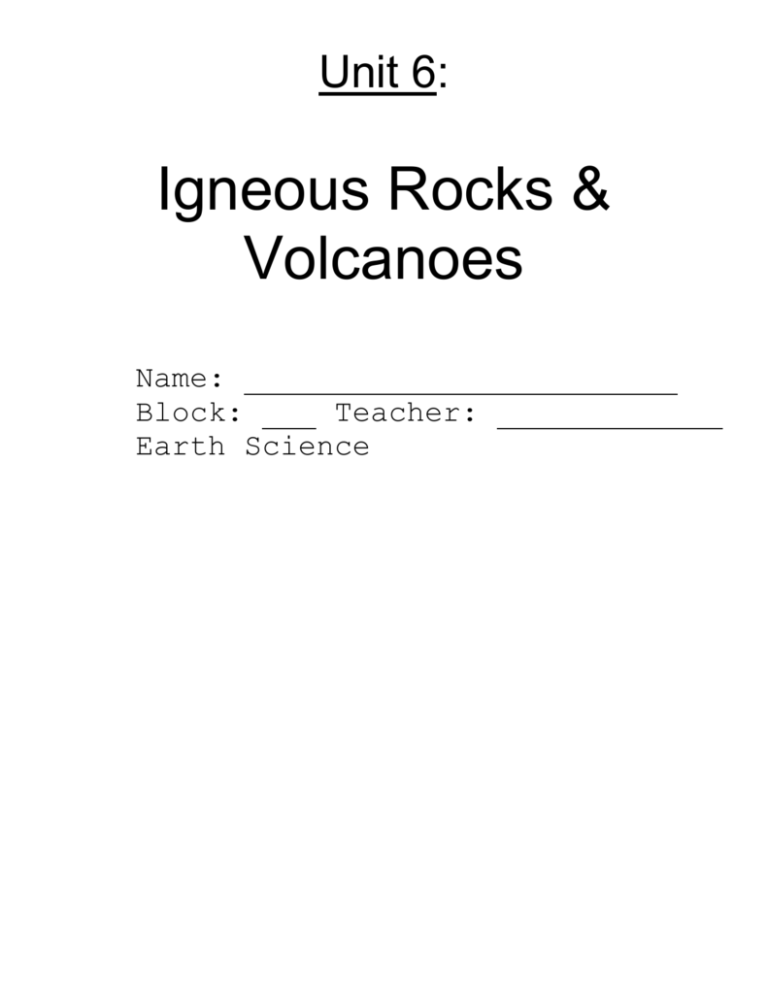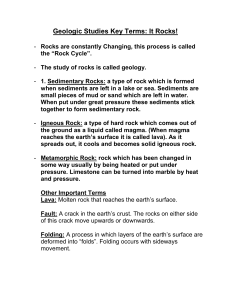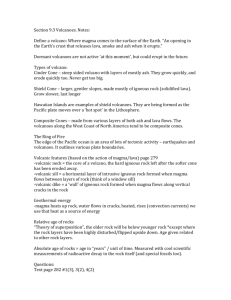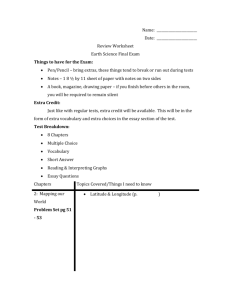volcanic igneous
advertisement

Unit 6: Igneous Rocks & Volcanoes Name: Block: Teacher: Earth Science Table of contents Page # 1 Page Title/Assignment Daily Warm Ups 2 Vocabulary Illustrations & Examples 3 Igneous Rock vocab 4 Rock Cycle Poster 5 Rock Cycle Info 6 Texture labeling Compare & Contrast: Venn diagram 7 Igneous Rock Notes 8 Landform Labeling 9 Intrusive Igneous Rock Structures 10 What type of Volcano am I? 11 Volcano Notes Daily Warm Ups Warm Up # Date 1 2 3 4 5 6 7 Question(s) Answer(s) Illustrations & Examples Directions: For each vocabulary word, draw a picture or list some examples. Pictures can be inspired by the definition of the word. Examples can include things in general that make you think of the word, or you may look some examples up on the internet. Vocabulary 1. rock: 2. rock cycle: 3. igneous rock: 4. lava: 5. magma: 6. felsic: 7. mafic: 8. pluton: 9. batholith: 10. laccolith: 11. dike: 12. sill: 13. intrusion: Rock cycle poster/drawing Directions handed out in class and posted on website. Rock Cycle Questions Read pp. 118-120 in your textbook. Answer the questions below. These are your notes! 1. What is a rock? How are they alike and different from minerals? 2. (True/False) All of the different types of rock can become any other type of rock. 3. Is the rock cycle one single pathway or a complex web of alternate pathways? Defend your answer. 4. Fill out the follow chart about the 3 different types of rocks: This type of rock… Igneous Rocks …comes from this type of material… …and are formed by these processes Sedimentary Rocks Metamorphic Rocks APPLICATION: How do you think plate tectonics affect the Rock Cycle and its processes? (You can use your Plate Tectonics INB!!!) Igneous rock texture Name the type of igneous rock texture that each picture represents. A. B. C. Compare & contrast Fill out the Venn diagram to compare and contrast intrusive and extrusive igneous rock textures. Extrusive Intrusive Igneous rock notes Igneous rocks are formed by the molten rock ( or CLASSIFICATION: 1. 2. Texture of of ). Composition MINERAL COMPOSITION: Felsic: amounts of silica & Mafic: amounts of silica & Amount of silica determines composition: more than 65% silica content 50-65% silica content less than 40-50% silica TEXTURE OF GRAIN SIZE: depends on Where it forms, will change the 1. ABOVE GROUND: from called or rocks cool and crystals have a limited time to form; as a result there are or Resulting textures: 1. 2. 3. 2. BELOW GROUND: from called cool so time to form Resulting texture: 1. or rocks mineral crystals have Intrusive igneous rock structures DIKE Sheet-like Igneous rocks that structure of pre-existing rock the SILL Sheet-like Igneous rock that layering of pre-existing rock to the LACCOLITH developed sills BATHOLITH large mass of Igneous Rock, which usually makes up the core of mountains Volcano notes : Area surrounding the pacific plate where the most volcanoes & earthquakes occur VOLCANIC ACTIVITY: : recent eruptions, active magma source : no recent eruptions, but still has an active source of magma : no recent eruptions, no source of magma VISCOSITY: the of lava to flow (honey vs. water) more viscous, the the material depends on the amount of type of being melted determines the amount of 3 TYPES OF VOLCANIC CONES: 1. : explosive eruptions, small but steep slopes, pyroclastics 2. : non-explosive eruptions, fluid basaltic lava, gentle broad slopes 3. : alternating between lava and pyroclastics, explosive and non-explosive eruptions, very steep/tall VOLCANISM @ DIFFERENT PLATE BOUNDARIES Intrusive structures Using your notes on p. 9, label the four pictures below. What type of volcano am I? 1. Description: Mayan Volcano 2. Description: Kilauea Volcano Thick clouds of ash blanketed villages at the foot of this volcano. A series of powerful eruptions sent residents fleeing and cut power to thousands of villages. In each explosion, the volcano belched red hot rocks and a column of ash as high as 7.5 miles. Lava raced down the slope at 50 mph. Lava was welling up vigorously on the western side of this lake, moving west to east across the lake and pouring into a 30x30 meter incandescent hole. The constantly churning lake surface was almost entirely incandescent. Lava consumed the 700 year old Waialua Heian temple. Lava poured over the 4 foot high walls and continued on into the ocean. In both 1989 and 1990, lava crept near the temple but was diverted around it. Type: Type: Evidence: Evidence: 3. Description: Mt. Etna Volcano 4. Description: Paricutin Volcano On 2/14, this volcano erupted and shot ash and rock through its southeast crater. Lava flowed down the uninhabited flank of the volcano. Ash was found 15 miles from the volcano. Two coastal communities located on Mt. Etna’s slopes were covered in ash. On 10/25 glowing rocks were shot into the air. Volcanologists expect a lava flow will eventually work its way through a fissure in the central crater and move down its western slope. Paricutin is the famous “volcano that grew out of a cornfield”. It was not really a very dangerous eruption for people, but it was quite destructive of their agricultural lands, livestock, and a way of life. The eruption lasted from 1943 until 1952, produced a large cinder and ash cone, and covered an area about 8 km by 8 km with slow-moving lava flows. Type: Type: Evidence: Evidence:






